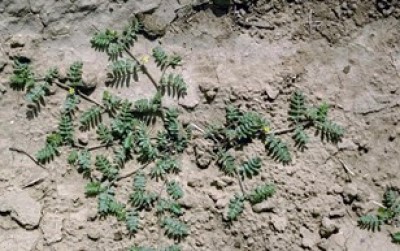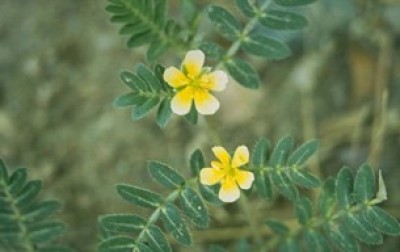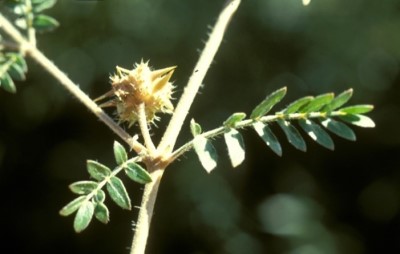Puncturevine (Tribulus terrestris)
Introduction

Photo by Howard Schwartz, Colorado State University, bugwood.org
Puncturevine, also called “goatheads,” is native to southern Europe, but it is currently widely distributed around the world. It inhabits all states in the western U.S. The earliest record of the species in Montana was 1938, where it was found growing along a railroad right-of-way in Yellowstone County.
Identification and Biology
Puncturevine is a summer annual plant in the Zygophyllaceae family. This plant grows low to the ground in a prostrate and sometimes mat-forming fashion with stems up to three feet long. It has small, yellow flowers with five petals and opposite, pinnately-compound leaves. Burs are comprised of five segments each with two large, sharp spines accompanied by several sharp bristles. Each bur may contain up to 20 seeds.
Habitat and Spread

Photo by LL Berry, bugwood.org
Puncturevine inhabits a variety of disturbed habitats. It is commonly found on dry, sandy or gravelly soils. In Montana it is often found along roadsides and in waste places, along with streambanks. Other habitats include pastures, crop fields, field margins, and parks. The sharp burs aid in seed dispersal by clinging to animal fur or sticking to their feet.
Impacts
People and pets can be injured by the sharp burs, and recreational activities can be seriously impacted where puncturevine is abundant. For example, one bicycle repair shop in Billings, MT, reports repairing 25 to 30 flat tires a day during certain times of year due to puncturevine burs. For grazing animals, the burs can cause lameness. Puncturevine also contains toxins that cause photosensitization in cattle and sheep. Poisoning from puncturevine can be fatal. It is reported that puncturevine is not commonly a toxicity issue if adequate forage is available.
Management

Photo by Steve Dewey, Utah State University, bugwood.org
Puncturevine is a plant almost exclusively of disturbed areas, so limiting bare ground and encouraging a competitive desired plant community are good prevention strategies. Mechanical control such as tilling or hoeing is effective if accomplished before seed production. Hand pulling before the spiny burs have formed works well for small patches. Mowing is not recommended because the plant grows low to the ground, usually below where mower blades can reach. There are many herbicides reported to be effective if applied to young, rapidly growing plants including 2,4-D and glyphosate.
Further Information
More information about toxicity
More information about management
For more information about this month's weed post, contact Extension Invasive Plant Specialist Jane Mangold. Past posts are available in the Monthly Weed Post Directory.
This weed post is also available as a printable PDF (702KB).
